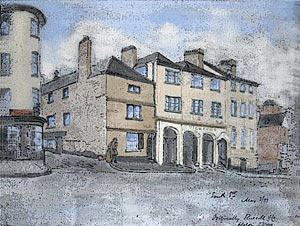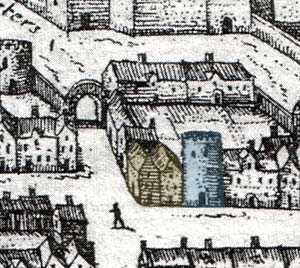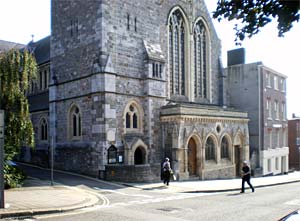
Bear Inn - South Street
and College Kitchen/Bear Inn
Page updated 26th April 2012
This inn, which closed sometime in the early 19th Century, was one of the most important in Exeter. It was described as "Second in size to the New Inn (High St)" by Hoskins.
Now the site of the Sacred Heart Church on Bell Hill, South Street, the inn gave its name to Bear Street. It was first recorded in 1286, when the Cathedral Close was walled, and the gates were built. There is a record of it being rebuilt in 1481.
The name Bear, is a corruption or a pun on the name Bere - the inn was the town house of the Abbots of Tavistock who ran one of the richest abbeys in Devon from the tin, lead and silver mines at Bere Alston.
Jenkin's wrote in his History of the Cty of Exeter published in 1841, "The Bear Inn, in South-gate-street, was the site of an ancient Priory, founded by Bishop William Warlewest; it was an appendage to the Priory of Plympton, whose Prior had sumptuous and convenient lodgings here for his accommodation, whenever he resided in this city. Great part of the old buildings, particularly the chapel, was standing a few years since; "
In 1539, it was described as "le Bere Inne alias Bere" in a lease from the last abbot to Edward Brygeman and his wife Jane, that ran for 60 years.
In 1545, after the dissolution, the freehold was granted by Henry VIII to William Abbot. It went through a series of owners, including a former Mayor of Exeter. In 1566 the following Last Will stated:
"William Buckenam Clerk; (sometime Mayor of this City) by his Last Will and Testament, dated 8 Elizabeth, Anno Domini 1566, bequeathed to this Chamber One full Moity (half portion) or Halfendeal of all that Tenement, with the Appurtenances commonly called the 'Bear-Inn in South, gate-street for the Benefit of the said Alms-house; which at present is stated out under the yearly Rent of Ten Pounds."
It was common in the 16th century for members of the City Chamber (Council), and other wealthy individuals, to leave money or property to the Chamber to be used for supporting the poor. The income was then used to operate the house of correction (workhouse), provide grain at times of high prices, or meals either weekly, or on Saints days. In the above will, the rent was to be used to benefit an almshouse.
The inn had a great window with a painted glass scene depicting the coat of arms of Tavistock Abbey and its founder, Ordger, and the figure of a man standing on a bridge, thought to refer to the already mentioned, Edward Brygeman, who was also the warden of the Exe Bridge. The building was described, again by Jenkin's as "...they were built with free-stone, of excellent gothic workmanship, decorated with fretwork panels; mutilated inscriptions, and different sculptures were seen, and over the cornice, even with the battlements, was a cabossed statue of a bear, holding a ragged staff between its paws, (the badge of the ancient Priors of Plympton.) This venerable pile of building, being in a ruinous state, was pulled down, and a dwelling-house, offices, &c. erected on the site, by Mr. Robert Russel."
In 1626, the Bear Inn witnessed an early encounter with the young George later General Monck. Whilst drinking in the Inn with his elder brother Thomas and a friend, John Pollard, they saw Nicholas Battyn who had arrested Sir Thomas Monck, the boys’ father, the previous year. Anxious to avenge their father’s honour they took up their cudgels and swords. George pursued Battyn and thrust his sword at him knocking him to the ground before escaping. All three were caught and Thomas and John were bailed while George stayed in custody for five days until he was also bailed. It appears Battyn died, as George was rearrested ‘per suspicion of murder’. Possibly to escape hanging George joined the English forces in 1627.
The Civil War
During the civil war when Exeter was under the control of Parliament in 1642/3 supporters of the King were in danger if they expressed opposition to the authorities. A musician named George Gallop was investigated for encouraging the singing of a 'scandalous song' about members of the House of Commons, in the Bear Inn. It is likely that the Bear was regularly frequented by Royalists as many in Cathedral Close, including most clergy, were anti Parliament. The Bear Inn was close to the Bear Gate.
An early mention in Andrew Brice's Post-master, was a notice for a sale in April 1721 of 'Valuable Books in Divinity, History, Law, Physick, & c.... will be sold, by way of Auction, at the Bear-Inn in Southgate-street'.
Russell's the carrier service
Through the 17th and 18th Century, the Bear became an important terminus for carrier services around Devon and beyond, and it was noted for the number of packhorses it could accommodate, before the waggon took over as the turnpikes improved. An landlord of the inn at this time was Simon Phillips, from 1779, and his wife Mary from 1796 - the inn as a drinking establishment was in decline even though Russell's, the carrier service had used the premises from around 1786, for a weekly service to London.
Through the first decade of the 19th-century, the Bear Inn was a frequent venue for property sales, sometimes on a weekly basis, and used by commissioners of bankruptcy to pay out dividends to creditors. In December 1802, John Holman announced that he had taken over the Bear Inn "... which is lately fitted up neat and convenient..." It was up for let again in 1805, and the Bear Inn does not appear in the Flying Post again.
Eventually,
Russell's carrier service took
over the premises completely. Jenkin's also included a footnote regarding Russell's "Mr. Russel is the principal of a large concern in the waggon business, in
which are employed a great number of horses. In 1798, when the French
threatened invasion, lie offered to assist government with three hundred capital
draught horses, and to have them in readiness whenever required."
Russell's remodelled the buildings in 1800 to suit their business, and heavily laden wagons would leave for both local and long haul destinations, with a regular service to London, carrying long ells ( a type of serge) for shipping to China in return for tea, by the East India Company. Russell's introduced the famous Flying Waggons, that would run through the night in the four and a half day journey to London. Robert Russell became wealthy from his business, and retired in 1816, to build Russell House on Exmouth quay, where he died in 1822. Russell's carrier service continued to run as Robert sold the business to a consortium of eight men. The business continued until 1853 with the Bear Inn used by Pickfords after that date until it was demolished.
The Bear Inn was replaced by the Sacred Heart Church that dates from 1885. In a French Gothic style, it used a 15th-century window from the old inn on the staircase leading to the choir loft.
On the opposite corner of Bear Street stood the Bear Tower, a 14th Century building which served as a house from the 19th Century. It was damaged during the May 1942 blitz and stood as a ruin until 1966 when it was removed and replaced by a planted space.
College Kitchen/Bear Inn at 9 South Street
In the 19th Century there was a second Bear Inn in South Street. Situated further up South Street, on the same side, it was part of the College of the Vicars Choral, and stood close to the public conduit in front of the College Kitchen. The inn was converted from the kitchens - according to the will of John Bussell dated 1773, he bequeathed his leasehold tenement in The Close known as the College Kitchen, then in the occupation of Edward Tapp and others as tenants, to his daughter Mary. The College Kitchen first appears in local directories from 1822 with Susannah Ford (died 1835) and with William Hely Smith in 1830. An article reminiscing on old Exeter in 1873, mentions how the College Kitchen public house, during the time of Mr Ford, had a doorway knocked through a six foot stone wall allowing access to the Close after the gates had been locked.
After that date, the establishment is named the Bear Inn, and was run by Stephen Compton from 1835, and then his wife after he died. In 1857, a to let notice appears for the "old-established Free Inn which has been successfully conducted by the present Tenant for twenty-two years" and in the July the license was transferred from Mrs Sarah Compton to Mr George Leach. In 1860, Leach's 2 year old son died. William Gibbs was the last landlord in charge and in 1871 the session for granting licenses asked Mr Gibbs, if he intended to apply for a renewal of the license once the establishment was rebuilt, to which he replied that he would. Mr Barton stated that "it was clear the house was not in a fit ".
It was photographed in 1871 when it was in the process of being demolished and it was not rebuilt as a public house.
Source - Samuel Izacke 1731 , Robert Dymond, W G Hoskins, Peter Thomas, Todd Gray/Hooker, trade directories, Exeter 1540-1640 by Wallace MacCaffrey, and Loyalty and Locality by Mark Stoyle. With thanks to Julia Sharp for the General Monck research and Peter Selley for the detail of John Bussell's will. © 2012 David Cornforth - not to be used without permission.
 A pencil drawing of the Bear Inn drawn in
1881, that has been tinted to give solidity. The house of the Abbot of Tavistock was the left building of the group, while the entrance to the Bear Inn and yard was through the arched frontage. The house to the right was probably Russell's private residence. The round building to the left was in front of the
Bear Tower.
A pencil drawing of the Bear Inn drawn in
1881, that has been tinted to give solidity. The house of the Abbot of Tavistock was the left building of the group, while the entrance to the Bear Inn and yard was through the arched frontage. The house to the right was probably Russell's private residence. The round building to the left was in front of the
Bear Tower. The House of the Abbots of Tavistock is shown in brown and the entrance to the yard is shown in blue. Russell's made extensive alterations in the early 19th Century. From Hogehnegh's map of 1618.
The House of the Abbots of Tavistock is shown in brown and the entrance to the yard is shown in blue. Russell's made extensive alterations in the early 19th Century. From Hogehnegh's map of 1618. The
sacred Heart Church, the site of the Bear Inn. Note the Georgian
building to the right, which also appears in the drawing. The arched
doorways and windows at the front are an echo of the façade of the
former inn.
The
sacred Heart Church, the site of the Bear Inn. Note the Georgian
building to the right, which also appears in the drawing. The arched
doorways and windows at the front are an echo of the façade of the
former inn. A window
that survived from
the Bear Inn, that is in the Sacred Heart Church.
A window
that survived from
the Bear Inn, that is in the Sacred Heart Church.
│ Top of Page │